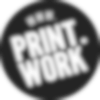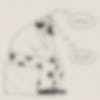Adding that extra sparkle to your design does come with a bit more work in terms of file set up, but the work doesn’t have to be difficult. We are here to make it simple so all your designs can shine!

What is metallic ink?
Metallic ink is a layer of iridescent silver ink that can be printed either as a standalone finish or combined with overprinted colour to create a wide variety of eye-catching effects.
It gives off a matte silver effect with a light glittering shimmer, which can really make your design pop – however it’s worth noting that it’s very dependent on the light you have around you. If you are in a bright environment with a strong light source you will see more of that sparkle. In low level light, the ink may appear a little flat.

What will I need to start?
Before you begin preparing your files for metallic ink printing, we’d advise making yourself familiar with the below.
Vector or Bitmap?
A brief little file type lesson here, don’t be scared. There are two different ways a file can be made up, the most common is a bitmap file. This is a file that’s made up of pixels. When you zoom into your image you’ll see the file is made up of many tiny pixels of all different colours.
A vector is different. Instead of using pixels, a vector image is created using mathematical equations, using fixed points and lines to create a solid shape which can be made larger or smaller without losing any quality in the design.
Spot Colour
The metallic ink layer will need to be provided as a spot colour. A spot colour is an area of colour in an artwork which has an assigned name to it which the printer recognises. When the printer reads that spot colour, it knows exactly what makeup of ink to lay down on the printed sheet. SILVER is the key word here, all of the artwork in your metallic ink layer needs to be in a spot colour called ‘Silver’.
Now depending on what program and file type you are working with there are slightly different instructions for creating a spot colour.

Preparing metallic artwork with Adobe Illustrator
If your artwork was created as a vector, we would advise using Adobe Illustrator to prepare the artwork for spot metallic printing, although Adobe InDesign works just as well and the below steps are transferable to this program as well:
- First, ensure your document/canvas size is set up to the size you’re looking to be printed, with 3mm bleed on each edge of the artboard.
- Outline any fonts used in your design. On Adobe Illustrator or Adobe InDesign this is achieved by selecting ‘type > create outlines’ whilst having text selected. Any linked assets in the design should also be embedded.
- We need to separate your artwork into two layers – a ‘COLOUR’ layer and a ‘METALLIC’ layer.
- All artwork which is to be in metallic ink should be in the ‘METALLIC’ layer.
- Whilst having the artwork in the METALLIC layer selected, create a new colour swatch with the following information:
- Swatch name (case sensitive): Silver
- Color Type: Spot Colour
- Color Mode: CMYK
- C 0 – M 0 – Y – 0 – K50
- Select OK. This should recolour the artwork to silver. Apply to any strokes if applicable.
- All artwork that does not require any metallic finishing should be in the COLOUR layer
- Artwork that is to be printed over metallic ink should also be in the COLOUR layer.
- Select all of the artwork in the METALLIC layer. Whilst having this selected, select window > attributes and tick ‘overprint fill’ (and overprint stroke if necessary).
- Toggle overprint preview via View > Overprint Preview – you should be able to notice a silver tint over all the metallic aspects of the design.
- Export the artwork as a PDF, ensuring there is 3mm bleed on the export settings.
- To check if everything has been done correctly, open up your artwork in Adobe Acrobat. In the tools section open ‘Print Production’ and select ‘Output Preview’.
- Toggle between the ‘process plates’ and ‘spot plates’ to confirm everything is in the right layer.
- Supply this PDF when making the order and our artworking team will take care of the rest!

Preparing metallic artwork with Adobe Photoshop
If your artwork was created as a bitmap, we would require the artwork to be prepared using Adobe Photoshop in order to add the spot colour required for metallic ink.
- Open your artwork in Photoshop
- Ensure any text layers are rasterised.
- Make a selection of the artwork you wish to be in metallic, ensuring the accompanying layer which contains the artwork is also highlighted in the layers panel.
- Select the ‘channels’ tab, and then select the hamburger menu to the right of the panel with further options. Click ‘New Spot Channel’.
- In the dialog box, enter the name as ‘Silver’ – case sensitive. For the ink characteristics, have the colour as C 0 – M 0 – Y – 0 – K50 and select OK.
- Please ensure the ‘silver’ channel is the lowest channel in the channel list.
- Save the artwork as a PDF.
- To check if everything has been done correctly, open up your artwork in Adobe Acrobat. In the tools section open ‘Print Production’ and select ‘Output Preview’.
- Toggle between the ‘process plates’ and ‘spot plates’ to confirm everything is in the right layer.
- Supply this PDF when making the order and our artworking team will take care of the rest!
Tips and Tricks
Metallic inks can be heavily influenced by the paper type and overprints in your artwork. The below tips will help get the most out of spot metallic to make sure you get the desired shine!
Top Tips
- Our coated paper stock Beluga Smooth really enhances the shine of the metallic ink.
- When overprinting make sure your colour has a low percentage of K value.
- The higher percentage of C / M / Y makes for a brighter colour and maximum vibrancy.
- If you have a high percentage of 3 or more CMYKs the silver might get lost.
- Overprint the metallic ink with a gradient texture to create a holographic effect.
Things to Avoid
- Avoid dark colour tints for overprinting – they will absorb some of the silver ink and dull the shine.
- The metallic ink on textured papers like Perlino Cotton and Oribi Straw won’t sparkle as much.
- Using thin strokes of very small type weights can cause a registration issue where the silver and the CMYK don’t align perfectly.
If you’re having trouble preparing your artwork for metallic ink printing, or you would like us to check any over your artwork prior to placing an order, please do drop us an email and a member of our artworking team will be more than happy to assist – artwork@print.work



